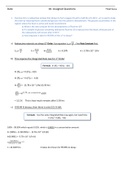Other
[CHEM 1220]Assignment #1
- Course
- CHEM 1220 (CHEM1220)
- Institution
- Langara College ( )
[CHEM 1220] These are the completed assigned questions . It may look like only 4 questions, but it can easily take 8-10 hours to complete (especially since these assigned questions are for the 1st month). Question 4 involves extensive calculations and will take the longest.
[Show more]



